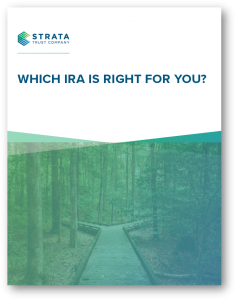Asking the right questions is a powerful tool for unlocking the value between you and your investors. Unfortunately, not all investors know the exact questions to ask to ensure their IRA options are being addressed appropriately. Being proactive in your consulting approach will help you discover how to distinguish the best path in leveraging a self-directed IRA in the alternative investment marketplace.
Here are 10 important IRA questions that investors may not know to ask:
 Do I have to wait until the day I turn 50 to make a catch-up contribution?
Do I have to wait until the day I turn 50 to make a catch-up contribution?
No. Eligibility for making catch-up contributions starts on January 1 of the year containing your 50th birthday. You may make a catch-up contribution for the calendar year you turn 50 at any time between January 1 of the year you turn 50 and April 15 of the following year.
 I will turn 59 this year. When can I take an IRA distribution without being subject to the 10% early distribution tax?
I will turn 59 this year. When can I take an IRA distribution without being subject to the 10% early distribution tax?
You will not meet the age exception to the 10% early distribution tax until you reach age 59½, when 6 months have passed after your 59th birthday. For example, if you wear born March 1, 1962, your IRA withdrawals will no longer be subject to the additional tax beginning September 2, 2021.
 How can I maximize our pre-tax retirement savings if my spouse doesn’t have a job?
How can I maximize our pre-tax retirement savings if my spouse doesn’t have a job?
If you have income to support the contributions and you file a joint federal income tax return, you and your spouse can each contribute the full annual limit of $6,000 to a Traditional IRA, for a total of $12,000. (An IRA must be established in each person’s name.) If you both are 50 or older, you can contribute $7,000 to each IRA, for a total of $14,000.
If you participate in a retirement plan at work, you and your spouse can still contribute the maximum annual contribution to your IRAs, but your eligibility to take a tax deduction for the IRA contributions may be affected, depending on your level of income.
 Can I invest my IRA in my brother’s business?
Can I invest my IRA in my brother’s business?
The tax laws generally prohibit transactions between an IRA and the IRA owner’s family members to prevent sweetheart deals and tax avoidance strategies. This includes the IRA owner’s spouse, parents, grandparents, children, and grandchildren (and any spouses). Siblings, however, are not disqualified persons for IRA purposes. But because the relation is so close, you should first consult a tax or legal professional to make sure your investment will not violate any of the prohibited transaction rules.
 Will my beneficiaries be able to take tax-free withdrawals from my Roth IRA right after my death?
Will my beneficiaries be able to take tax-free withdrawals from my Roth IRA right after my death?
The contributions you made to your Roth IRA will always be distributed tax-free, whether distributed to you or to your beneficiaries after your death. The investment earnings in your Roth IRA will also be immediately tax-free to your beneficiaries if you owned a Roth IRA for at least five years before your death. If you have not, then your beneficiaries must wait five years from the year for which you made your first Roth IRA contribution (or conversion) before they can distribute investment earnings tax-free from the Roth IRA.
 Do I earn too much money to contribute to a Roth IRA?
Do I earn too much money to contribute to a Roth IRA?
The tax laws prohibit higher earners from being eligible to contribute to a Roth IRA. If you’re single and your modified adjusted gross income is more than $125,000 per year, your eligibility to contribute to a Roth IRA is phased out until your income reaches $140,000, at which point you are not eligible to contribute to a Roth IRA. If you are married filing a joint tax return, the phase-out range is $198,000–$208,000.
There are no income restrictions on eligibility to contribute to a designated Roth account in an employer’s 401(k) or 403(b) plan or on eligibility to convert pre-tax IRA or retirement savings to a Roth IRA (a taxable transaction).
 I want to put money in my IRA this year, but what if I suddenly need that money for an emergency?
I want to put money in my IRA this year, but what if I suddenly need that money for an emergency?
Unlike a qualified retirement plan, an IRA allows you to access your IRA savings at any time for any reason. Although money taken out of a Traditional IRA is typically taxable to you, if you remove a contribution made for one tax year by your tax return deadline (including extensions) for that tax year, you will only pay tax on any investment earnings attributable to the contribution amount you take out.
 Can my IRA borrow money to purchase an investment?
Can my IRA borrow money to purchase an investment?
You are not allowed to borrow money from your IRA, nor can your IRA borrow money for most purposes. However, a special type of loan, called a non-recourse loan, may be used by your IRA to purchase real estate if the property purchased is the only collateral for the loan. In case of default, the lender cannot pursue the other assets of the IRA or your personal assets. The lender’s only remedy is to repossess the property being financed and foreclose on the loan. Your IRA may have to pay annual taxes on any income (e.g., rent) that is attributable to the financed amount.
 I want to take money from my Roth IRA to help pay for my daughter’s college expenses. What should I know before I do?
I want to take money from my Roth IRA to help pay for my daughter’s college expenses. What should I know before I do?
If you distribute no more than you have contributed to your Roth IRA, the distribution will be tax-free. If you take out more than your contributions and tap into the investment earnings, the earnings will be taxable if you do not meet the requirements for a qualified distribution.
A qualified higher education expense is an exception to the 10% early distribution tax for withdrawals before age 59 1/2, but it is not an exception to regular income tax on a taxable IRA distribution. Although Roth IRA balances do not have to be reported on the Free Application for Federal Student Aid (FAFSA) application, distributions from Roth IRAs must be included as untaxed income on an application two years after the year of the withdrawal, which can reduce your daughter’s financial aid award.
 How frequently can I move my IRA assets?
How frequently can I move my IRA assets?
The IRS limits how often you can withdraw IRA money payable to yourself or to a taxable account and then re-deposit it into an IRA without tax consequences, referred to as a rollover, to once every 12 months. But there is no IRS limitation on how often you can move IRA assets each year if you directly transfer assets from IRA to IRA.

Learn More About IRAs
Explore how self-directing an IRA enables investors the flexibility to build a powerful investment strategy. If your investors are unsure which option might be right for them, Which IRA is Right for You takes a deeper dive into IRA options available for individuals and business owners.
Download Today











